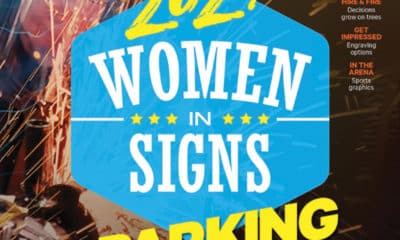LEDs + Lighting
LED-based Electronic Message Centers Rising
Published
15 years agoon

In a recent study conducted by a respected research firm Arbitron, more than half of the respondents said they found digital billboards attractive. Likewise, 64% of all people polled said that digital billboards are “a cool way” to advertise. When young adults 18 to 34 years old were asked the same question, favorable reaction rose to 77% among the respondents. Nearly 70% of the young adults also believed that digital billboards provide useful information.
–OAAA
LED-based lamps, a sizzling topic in the lighting and semiconductor industries, are occasionally examined in the general media, but, interestingly, the advertising and communication media, despite Ashton Kutcher’s efforts, hasn’t seemed to notice the LED-based, electronic-media phenomena.
Kutcher, in April, ran an Oprah-provoked, social media (Twitter) popularity contest against CNN.com news. Kutcher used donated, electronic-digital billboard space and, on final count, beat CNN’s Twitter-following score.
The winner would donate significant money to malaria relief in Africa.
Lamar Advertising helped. It narrowcasted “Follow Ashton Kutcher” across its national network of 1,133 digital billboards, which helped the actor score more than a million twitter followers.
Interestingly, Advertising Age magazine roared over Twitter’s success with this event, but then asked if Kutcher should be disqualified for using “old school” advertising. Billboards, albeit electronic and certainly modern, in this case.
Others believe he won because of the billboards.
The Advertising Age observation indicates that it and its Madison Avenue-type readers aren’t keenly aware of technologically modern, LED-based billboards and other outdoor electronic message centers (EMCs).
Lamar said it illuminated its electronic billboards for Kutcher within a few hours of accepting the agreement. The rapid response, it said, was due to LED-based technology after the company’s Amber Alert experience.
Many drivers don’t realize such billboards – EMCs – are LED-based displays. Similarly, many aren’t aware that the more archaic, monochrome displays, often found on the premises of local shopping plazas, are also LED-based EMCs.
To be fair, a few on-premise, flat-screen, electronic displays use LCD or other technologies; but currently, large-format electronic billboards installed alongside highways, and such areas as NYC’s Time Square and the Las Vegas Strip, exclusively use LED-based displays. Such displays are also popular in Europe and Asia.
Outdoor advertising’s rising power
Although technology has swept the globe, and “electronics” is a household term, the word “optoelectronics” is less recognized, even though electronics and optoelectronics are combined in LED-based digital displays. The term “electronics” spawned from “electron integrated circuits,” and, in a similar fashion, “optoelectronics” developed when optics (light sources) and electronics were integrated in the same device.
Integration reduces the in-box real estate.
LED-based EMC displays utilize optoelectronic technologies. There, the electronics systems process content data (and audio, when applicable) while optoelectronics systems display the visuals.
This audiovisual-content carrier system comprises software that combines with electrical, electronic and fiberoptic telecommunication technologies through both wired and wireless media.
LED-based, EMC billboards are effective means to advertise because, at roadside, they offer static messages that rotate every few seconds. This attracts attention and allows several advertisers to share the same location. When compared to standard, media-wrap billboards, they’re remarkably easier to change – no truck or crew required.
According to the Outdoor Advertising Assn. of America (OAAA), electronic digital advertising is among that industry’s most dynamic niches.
At the national level, both the OAAA and Federal Highway Adminsitration (FHWA) are researching the systems and adopting rules that state and local bodies usually accept as underlying standards, although many adopt their own statutes.
ST, the OAAA and others have reported on several safety studies related to electronic digital billboards. OAAA, in its website brief on safety, said, “No matter how the accident data were analyzed, the conclusion was the same: Digital billboards are not related to accidents.”
Within the outdoor realm, LED-based EMCs’ capabilities are enormous. The signs vividly display the full-color spectrum. And, within reason, they can match a client’s color requirements. Further, the operator/controller can almost instantly communicate with a client’s control center and update or change ads or messages within minutes.
Remotely, an operator can sequence ads, set frequencies and adjust brightness and color fidelity, based on ambient light conditions. For security purposes, some installed LED-based systems scan the area with remote-control television cameras.
Content matters
Outdoor advertising is visual storytelling in small instants of time. The audience views such messages at both emotional and rational levels; thus, the ad needs to convey the message effectively to the right audience, at the right time, in the right place. Understanding the dynamics and demographics of the marketplace is essential for designing effective outdoor campaigns.
Most states, counties or municipalities prohibit roadside animation on electronic digital billboards, but do allow timed changes (usually within 10 seconds or less) or static graphics images. Therefore, to create designs that comply with federal, national and local guidelines, electronic billboard ad designers must focus on both local regulations and the ad viewers’ perspective. Marketers, because they’re reaching mobile consumers, must effectively present ads that can be read and comprehended within a very short time period.
Essential, clear and attractive information must be displayed in a burst of time; therefore, successful digital billboard ad writers use short and simple messages. Collaborating designers, to ensure quick product identification, use legible fonts and effective colors, with appropriate contrasts and colors for logos and brand names.
Content designers should also generate files with a picture resolution and aspect ratio compatible with the planned electronic display’s size and pixel pitch. Oversized resolutions consume computer processing and file transfer time, but don’t affect image sharpness.
I’ve often conferred with John Williams, the vice president and division manager of YESCO (Las Vegas), who has worked with color, light and LED-based billboards for more than 20 years. He’s also often worked alongside Dr. Ian Lewin, an Illuminating Engineering Society of North America (IESNA) fellow and former president. Many see Lewin as the industry’s “light authority.” Both men have coordinated and analyzed LED-based billboard colors and brightness with OAAA for many years.
Dr. Lewin has an excellent paper on LED-based, billboard luminance at www.ies.org/E-Newsletter/pdf/Billboards.pdf. YESCO and Daktronics are two prominent U.S. manufacturers that supply LED-based billboards to Lamar and Clear Channel media.
Our belief – and I think OAAA would agree – is that certain color manipulations are necessary for average-vision viewers. For example, white backgrounds aren’t as vibrant as a single color, which is a mixture of RGB. One’s color perception changes as different amounts of ambient light surround the billboard; thus, the image designers use rich background colors for greater daylight impact, but use pastel backgrounds for greater night and cloudy-day vibrancy. LED-based EMC technology can automatically compensate for these factors.
LED-based video processing adjusts color balances when ambient light changes through “gamma correction” – a sophisticated video processing that adjusts RGB ratios to keep color fidelity in the changing light environment.
Studies concerning the technology, viewing and messaging are ongoing, all from people with different perspectives, but who are intent on bringing this technology forward.
Hopefully, Advertising Age and retail-advertising media buyers will become increasingly aware of the growing use of electronics and optoelectronics and its impact on advertising and communication (think Amber Alerts) media. Kutcher’s instant and effective promotion was definite proof.
As president of LED-based Lighting Technologies, Dr. M. Nisa Khan consults in the solid-state lighting industry and educates consumers about LED-based lighting. She has a bachelor’s degree in physics and mathematics, and master’s and Ph.D. degrees in electrical engineering. Email her at nisa.khan@iem-asset.com
Advertisement
SPONSORED VIDEO
Introducing the Sign Industry Podcast
The Sign Industry Podcast is a platform for every sign person out there — from the old-timers who bent neon and hand-lettered boats to those venturing into new technologies — we want to get their stories out for everyone to hear. Come join us and listen to stories, learn tricks or techniques, and get insights of what’s to come. We are the world’s second oldest profession. The folks who started the world’s oldest profession needed a sign.
You may like
Advertisement
Subscribe

Magazine
Get the most important news
and business ideas from Signsofthetimes Magazine.
Advertisement
Most Popular
-

 News3 days ago
News3 days agoWoman Found Living Inside Supermarket Sign
-

 Projects2 weeks ago
Projects2 weeks ago4 of the Most Fun Sign Projects in Years
-

 News2 weeks ago
News2 weeks ago2024 Sign Contest Open for Submission
-

 How To1 week ago
How To1 week agoMaking the Grade with ADA Signs
-

 Real Deal4 days ago
Real Deal4 days agoA Family Sign Company Foists Their Youngest Upon the Business
-

 Editor's Note5 days ago
Editor's Note5 days agoThe Joy of Working
-

 Photo Gallery2 days ago
Photo Gallery2 days ago17 Sneak Peeks at the American Sign Museum Main Street Expansion
-

 Product Buying + Technology6 days ago
Product Buying + Technology6 days agoEco-Solvent Printers: Workhorses of a Signshop’s Stable











